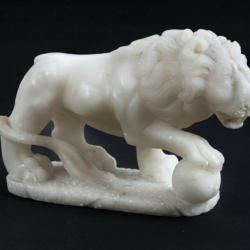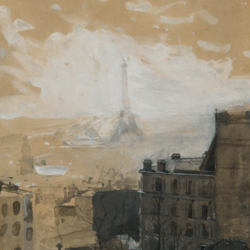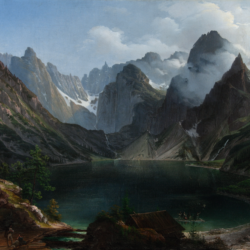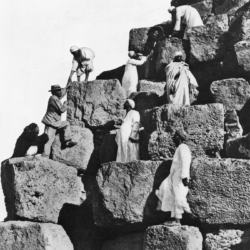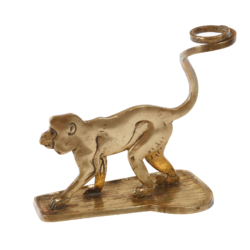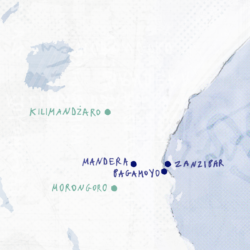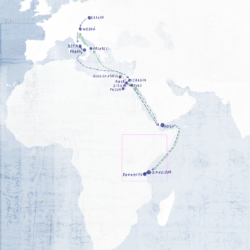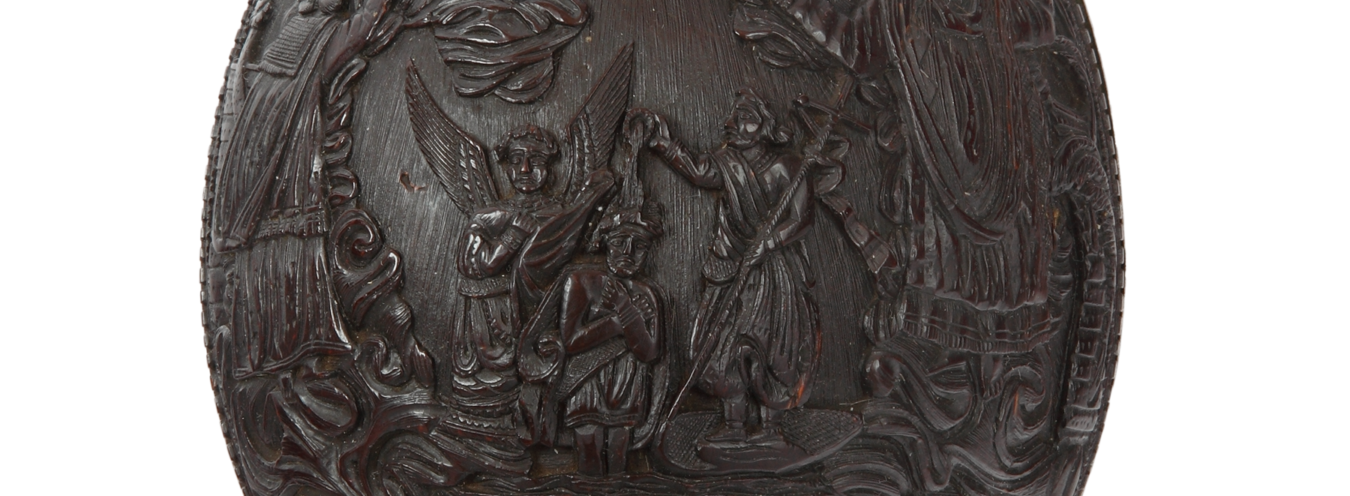
American nostalgia and the African dream
As stated above, marrying Maria Szetkiewicz marked his mental return to Europe for Sienkiewicz. He put down roots and took on the roles of a respected editor, a husband, and soon a father. It turned out, however, that dromomania may be restrained for some time but cannot be completely cured. It was not long before the writer’s letters to his former companion in some of his American adventures started to overflow with a wave of fond reminiscences of the United States, combined with fear of getting into a rut and dreams of revisiting the New World. In January 1882, Sienkiewicz wrote to Witkiewicz:
Paprocki works for us as a proofreader. Every so often, I surprise him with: “Do you remember us going to take a dump between the oaks at the Pleasants’?” Then, I can feel my blood rising against my own nature. I am going to remain a slave to the last of my colleagues if Marynia and I do not go to California in the nearest future. But when oh when will that happen? Life ends one day at a time at a rate so quick that it really scares me. Are you going to America? Say when – together we can surely do it. After all, let’s face it, we are going to get old, and we’ll have less and less eagerness, talent, and vitality. […] But if you went there to stay – I swear, we would come to join you in less than a year.[1]
Yet another telling element is the writer’s use of English words and phrases in his correspondence not only with Witkiewicz (who, as evidenced by e.g. his portrait of Sienkiewicz in a cactus forest, was quite sympathetic to his friend’s partiality) but also with other penfriends. This stylistic trick could be interpreted as yet another sign of nostalgia for America.
Around the same time, Warsaw sees the beginning of a fad for Africa. In September 1881, Stefan Szolc-Rogoziński announced his plan to explore the Cameroonian interior. It created a great stir in Warsaw, fueled by the enthusiastic coverage of the city’s most famous columnists, most prominently Bolesław Prus and Sienkiewicz himself.[2]
The “African discourse” of that time is surely a topic that deserves a more extensive analysis. Sienkiewicz’s concept of the continent, however, seems strongly informed by the vision of Rogoziński, whose perspective the writer seems to have accepted without any reservations. The young explorer presented what we might call Africa the Light Way: “vast spaces of fertile soil, spaces of life, spaces of the future.” He played down all possible difficulties and dangers. His youthful carefree arrogance prevented him from taking any notice of the opinions of his experienced predecessors, and he largely ignored the fact that the Dark Continent had its own unique character. Such a vision of Africa was a real magnet for Sienkiewicz. Apparently, he believed in it with his whole heart when he wrote in one of his columns:
The primal tribes that have not yet come into contact with white people […] are not cruel at all. Allegedly, those Negroes are much better than we are led to believe.[…] The land […] is fecund, so the expedition is not at risk of dying of starvation, as they would be in the Sahara Desert. The natural terraces of central Africa are covered either with primeval forests or with steppes teeming with herds of antelopes, zebras, and buffalo. Judging by the coastal regions, the interior is quite densely populated and used largely for farming. Pieces of glass, mirrors, and old uniforms can easily be exchanged for bananas and manioc.[3]
It would seem that the African project is just a perfect male adventure, a mere trip that combines the pleasant with the useful, a journey into the land of children’s and youth literature:
So far, five Poles have signed on [for the journey]. Some participants are going to stay on the coast as back-up, the rest is going to continue farther through the deserts, mountains, and woods. What does ‘farther’ stand for, exactly?… Let the reader fill in the gaps with their imagination… African people, elephants, gorillas… Starry nights resounding with lions’ deep bass rumbles, Verne’s adventure novel, A Thousand and One Nights… all this with a specific, scientific objective in mind. Indeed, the idea will fire up the enthusiasm of many, and more candidates will surely sign up.[4]
The above passage contains a revealing reference to Jules Verne’s fiction work. Without a doubt, Sienkiewicz alluded here to Five Weeks in a Balloon, or, Journeys and Discoveries in Africa by Three Englishmen (serialized for Polish readers in Gazeta Polska in 1863, and first published in a book-form in 1873). Sienkiewicz’s – and partly Rogoziński’s – mental picture of an African expedition displays the features of Verne’s fictitious one, where the protagonists may risk their lives but ultimately manage to emerge unscathed from any trouble owing to the strength of their minds and characters, and stopovers are enjoyed with meals of game washed down with grog, followed by cigar smoking.
One might well conclude that Sienkiewicz did not realize the extent to which his experience of American life would be different from the African realities. The nostalgia for “his” America and the imaginary dream of the Dark Continent both condition the writer’s yearning to visit Africa – though he was actually attracted by Verne’s artistic vision rather than curious of the real world.[5] This longing, reinforced with the fact that he really missed California, made him spin a web of odd theories and plans, thus presented to Witkiewicz in a letter of February 1882:
Rogoziński has been a frequent guest […]. With a winning straightforwardness, he told me that the natives who live on the coast do not let anyone pass to the interior to protect their trade monopoly, so “we are going to slink through to Pebot one by one at night.” Aren’t you laughing yet? I am laughing my head off. – The climate of the Cameroonian mountains, I hear, will be fantastically fine and healthy. […] As soon as I arrive, I’ll get letters from them. Janikowski (the meteorologist) will continue writing to me from the coastal station. If it is really as peaceful and healthy as they say, […] I will seriously consider coming to stay together with My Dearest One, all the more so as the station, that is the farm (with a house to live in, etc.), is bound to be ready: they will have completed building facilities by then. If that is the case, you’ll get married and come to join us. As for me, I would breathe easily for once; I often get practically suffocated here.[6]
In some of his letters, Sienkiewicz tags leaving Warsaw “an absolute necessity” and is serious about it up to the point of thinking not only about Africa but also an alternative plan:
And if it comes to nothing, California is my ultimum refugium.[7]
You see, I am no longer an island, thinking solely of myself. California, Africa, freedom, everything that I believe to be the best, the most sublime, the most liberating – I long for all that only for her sake now and will reach for it only when I am certain she has the same opinion of these treasures. – However, I am fully convinced that she is not always happy with our present time, either – and from time to time, she seriously addresses her parents like an obstinate child: “We’re moving to California!” Mamma becomes alarmed, and Pappa replies, “Whatever, as long as we sell the Lipków estate.”[8]
While the idea of a family relocation to Africa in many respects may be described as nothing but a pipe dream, it is hard to estimate how the far more feasible Californian scheme would have turned out in reality. However, Maria Sienkiewicz’s considerable health decline necessitated a journey closer to home: a tour of European health resorts, unfortunately without the happy ending.
Sienkiewicz’s dream of Africa lived on.
Przypisy
- Ibidem, pp. 310–311, emphasis B. Sz.; trans. J. M.
- For a more detailed analysis of Sienkiewicz’s African expedition, see B. Szleszyński, “ ‘Zresztą nie mamy czasu jechać do Afryki, bo musimy pisać sprawozdania o Sarze Bernhardt.’ O Kronice warszawskiej z 7 stycznia 1882 roku” [“No time to go to Africa, we have to write reports on Sara Bernhardt”: On Sienkiewicz’s column from January 7, 1882], in Sienkiewicz z innej strony [Sienkiewicz from another perspective], ed. T. Bujnicki, J. Axer, Warsaw 2014, pp. 84–94. The topic of Africa and Bolesław Prus is developed in B. Szleszyński, “Kolonialne fantazje i kolonialne koszmary w Zemście Bolesława Prusa” [Colonial fantasies and nightmares in Zemsta by Bolesław Prus], Wiek XIX. Rocznik Towarzystwa Literackiego im. Adama Mickiewicza 2014, vol.7, no. 49, pp. 207–228.
- See H. Sienkiewicz, “Kronika Warszawska” [The Warsaw column], in H. Sienkiewicz, Dzieła [Collected Works], ed. J. Krzyżanowski, vol. 53, supplement 1, Warsaw 1952, p. 10; trans. J. M.
- Ibidem, emphasis B. Sz.; trans. J. M.
- It should be mentioned here that the (altogether surprising) juxtaposition of both continents in one and the same text is made by Sienkiewicz as early as 1877, when he advises Daniel Zgliński to leave for “the banks of the Zambezi, the coast of Zanzibar or Oveuge [?]” as a remedy for the nerves, and compares it to his “wild” experiences back in California (Listy [Letters], vol. 5, part 2, op.cit., p. 585; trans. J. M.).
- Ibidem, pp. 313–314; trans. J. M.
- Ibidem, p. 314, emphasis B. Sz.; trans. J. M.
- Ibidem, p. 320, emphasis B. Sz.; trans. J. M.

